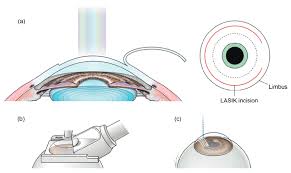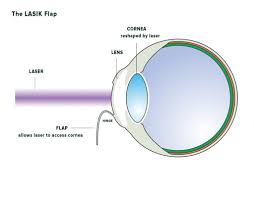Table of Contents
ToggleImagine a world free from dependence on glasses or contact lenses. This dream has become a reality for millions of people worldwide thanks to SMILE (Small Incision Lenticule Extraction) – a cutting-edge laser eye surgery technique.
If you’re curious about how SMILE works and whether it could be the key to unlocking a clearer vision, delve deeper into this comprehensive guide.
A Closer Look at SMILE’s Unique Corneal Reshaping
During the SMILE procedure, the femtosecond laser systematically creates a lenticule within the corneal layers, embodying the patient’s refractive error. In a swift motion, a precise disc of corneal tissue is formed, followed by the creation of a small incision to facilitate lenticule extraction. The removal of this disc reshapes the cornea, adjusting its refractive power to correct the patient’s vision.
The highly specified nature of this process ensures a tailored approach to each individual’s vision needs.
Before the Procedure: Setting Realistic Expectations and Qualifying for Success
Before embarking on the SMILE journey, it’s crucial to have a candid conversation with your ophthalmologist. While SMILE’s goal is to significantly improve your vision, complete independence from corrective lenses might not always be achievable.
You may still require glasses for specific tasks like reading fine print or driving at night. This is due to individual variations in vision needs and the inherent complexities of the human eye.
Preparing for SMILE: A Comprehensive Evaluation
Your ophthalmologist will conduct a thorough eye examination to assess your suitability for SMILE. This comprehensive assessment typically involves:
- Vision Testing:
This involves assessing your present vision acuity and gauging the extent of your nearsightedness (myopia) or astigmatism. It helps ascertain if SMILE provides the optimal solution for addressing your particular refractive errors. Vision testing is also crucial to verify that your vision remains stable. - Eye Health Evaluation:
A meticulous evaluation to rule out any underlying eye conditions, such as cataracts or glaucoma, that could potentially complicate the surgery or be impacted by it. - Cornea Mapping:
Utilising advanced technology to create a detailed map of your cornea’s surface and thickness. This crucial information provides a blueprint for the laser during surgery, ensuring precise and personalised treatment. - Pupil Size Measurement:
Measuring the size of your pupils helps the surgeon fine-tune the laser treatment for optimal results.
Understanding the Technology: The Power of the Femtosecond Laser
SMILE utilises the advanced features of the Visumax 500 femtosecond laser, showcasing a marvel of cutting-edge technology. This sophisticated laser functions at remarkable speeds, emitting ultra-short pulses of light that can intricately shape microscopic structures in the cornea while safeguarding neighbouring tissues.
Customised with precise measurements for your eye, this laser ensures accuracy and safety in the procedure.
The Five Steps of SMILE: A Journey Towards Clearer Vision
The SMILE procedure typically lasts 10-15 minutes, with the lens part taking only 22 seconds per eye. Here are the steps involved:
- Preparation:
Upon arrival at the surgical centre, you will be guided through the preoperative steps, which involve briefing about the surgery and final check-ups and answering any additional questions you may have. Your comfort is paramount throughout the process. Your ophthalmologist will administer numbing anaesthetic eye drops to ensure you don’t feel any pain during the surgery. An eyelid holder will gently keep your eye open, and a specialised contact lens might be placed on your eye to provide additional stability. Many people describe feeling pressure or a sensation of being pushed rather than pain. Also, like in other laser vision correction procedures, patients remain awake throughout the process. - Reshaping the Cornea:
The femtosecond laser comes into play. With remarkable precision, it creates a disc-shaped piece of corneal tissue within the cornea’s inner layers. This disc, called a lenticule, is meticulously sculpted based on your unique corneal topography and refractive error. - Creating the Access Point:
The femtosecond laser then creates a tiny incision within the cornea, allowing access to the lenticule. This incision is typically less than 4 millimetres, minimising tissue disruption and promoting faster healing. - Removing the Lenticule:
Through the created access point, your surgeon carefully extracts the lenticule. This removal process reshapes your cornea, correcting your vision. - Natural Healing:
The small incision created by the laser is self-sealing, eliminating the need for stitches. Your eye will naturally heal over the following days and weeks. SMILE surgery may sound intricate, but the recovery process is engineered with the patient’s comfort in mind. The postoperative phase focuses on allowing the cornea to stabilise and heal. The majority of patients can resume their daily activities within three to four days, though it is essential to follow the surgeon’s guidelines to ensure optimal healing.
Beyond the Procedure: Recovery and Reclaiming Your Freedom
After undergoing SMILE, it’s advisable to arrange for a ride home post-procedure and plan to rest for the remainder of the day. Your ophthalmologist will furnish comprehensive postoperative instructions, encompassing medication and eye drop schedules, as well as activity restrictions. Refrain from exposing your eyes to water for several days. Additionally, your physician might suggest wearing an eye patch while sleeping for a week to prevent inadvertent eye scratching.
Most patients experience minimal discomfort and resume their regular activities, including work, driving, and even light sports, within a few days.
Beyond the Basics: Advantages and Considerations
SMILE offers several advantages over traditional LASIK surgery, including:
- Minimally invasive procedure:
Smaller incision size and minimal tissue disruption lead to faster healing and potentially lower risk of complications. - Enhanced corneal strength:
Preserves the structural integrity of the cornea, potentially reducing the risk of dry eyes and other complications. - Faster recovery:
Patients often experience quicker visual recovery compared to LASIK. However, it’s essential to recognise that SMILE may not be suitable for everyone. Here are key factors to address with your ophthalmologist: - Degree of refractive error:
While SMILE effectively corrects nearsightedness and astigmatism, it may not be ideal for individuals with severe conditions or complex vision issues. - Corneal thickness:
Adequate corneal thickness is necessary for the safety and success of SMILE. Your ophthalmologist will assess your corneal thickness to ensure it meets the procedure’s requirements. - Age:
Although there’s no strict age limit, SMILE is generally recommended for those above 22, as younger eyes are still developing. - Overall eye health:
Pre-existing eye conditions like dry eye or corneal abnormalities could impact the outcome of SMILE or pose additional risks.
Informed Decision-Making: Consultation with Your Ophthalmologist
The choice to undergo SMILE should be a collaborative decision with your ophthalmologist. They will evaluate your specific needs, discuss your vision objectives, and conduct a thorough assessment to determine if SMILE is the best option for you. Feel free to ask questions and share any concerns to ensure you are fully informed and confident in your decision.
Beyond the Procedure: Embracing Clearer Vision
For many seeking freedom from corrective eyewear, SMILE presents a modern and efficient solution. By gaining insight into the procedure and its benefits and discussing it with your ophthalmologist, you can begin a journey toward clearer vision and reduced reliance on glasses or contacts.













